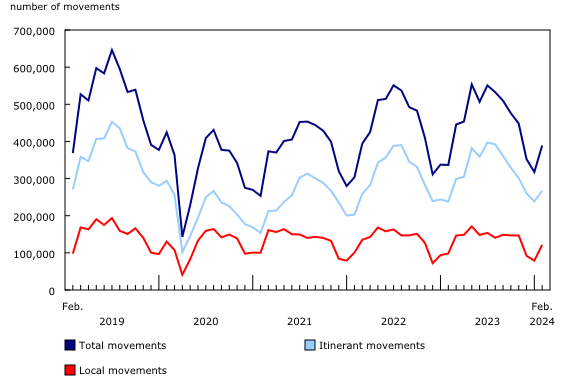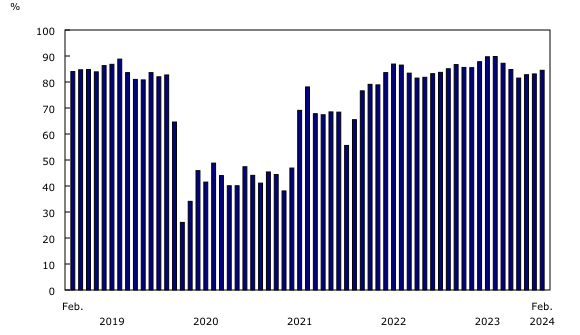Aircraft movement and civil aviation statistics, February 2024
Released: 2024-04-25
Highlights
In February, aircraft movements at Canada's major and select small airports totalled 389,143, up 15.6% from February 2023. Itinerant movements rose 12.3% year over year to 267,374, while local movements climbed 23.7% to 121,769.
At the same time, major Canadian airlines flew 6.7 million passengers on scheduled and charter services in February 2024, with the passenger load factor at 84.5%.
Consult the new Aviation Data Visualization Hub to explore data on aircraft movement statistics and on monthly civil aviation statistics in an interactive format.
Aircraft movements increase in all sectors
In February 2024, there were 29 days because of the leap year, while February 2023 had 28 days. Aircraft movements increased in all sectors compared with the previous year, partially due to this extra day. Domestic movements were up 12.3% year over year to 217,998 in February 2024, with widespread gains among many types of operations.
Other international movements (outside the United States) were up 17.8% from a year earlier to 17,468 in February 2024. This sector continued its strong recovery, remaining above the pre-COVID-19 pandemic level. Transborder movements to and from the United States increased 9.3% to 31,908.
Following a decline in January, local movements bounced back in February, increasing 23.7% to 121,769. In comparison, in February 2020, also a leap year, there were 130,192 movements reported, a year-over-year increase of 32.9%.
For the fourth consecutive month, airports in Ontario reported the highest number of aircraft movements, with 105,143 in February 2024, followed by British Columbia, with 100,989 movements.
Toronto/Lester B. Pearson International remained the busiest airport in Canada, with 30,111 movements, up 12.0% year over year. Pitt Meadows in British Columbia recorded the largest year-over-year increase, with an additional 5,636 movements from February 2023, followed by Abbotsford (+3,630).
Major airlines' operating and financial statistics
The seven Canadian Level I air carriers flew 6.7 million passengers on scheduled and charter services in February 2024, 16.1% more than in February 2023, when there were six Level I carriers.
The number of Level I air carriers increased from six in 2023 to seven in 2024, as one Level II air carrier was reclassified to Level I.
The number of passenger-kilometres in February 2024 was 18.0 billion and capacity was 21.3 billion available seat-kilometres. As a result, the passenger load factor (the ratio of passenger-kilometres to available seat-kilometres) was 84.5%, down slightly from that of 85.1% recorded in the same month a year earlier.
Each passenger travelled an average of 2,691 kilometres in February, up 2.0% from February 2023.
Level I carriers flew 174,000 hours in February 2024 and generated $2.2 billion in total operating revenue.
Did you know we have a mobile app?
Download our mobile app and get timely access to data at your fingertips! The StatsCAN app is available for free on the App Store and on Google Play.
Note to readers
As of reference month January 2024, Statistics Canada is publishing a new consolidated monthly release called "Aircraft movement and civil aviation statistics." The survey programs which support the new release are:
- Aircraft movement statistics (survey number 2715, tables 23-10-0296-01 to 23-10-0304-01)
- Monthly civil aviation statistics (survey number 5026, table 23-10-0079-01).
The tables associated with the above survey programs remain unchanged and will be updated as usual. Definitions, data sources and methods for each survey program remain available by accessing each survey's respective number.
Consult the new Aviation Data Visualization Hub to explore data from Aircraft movement statistics and Monthly civil aviation statistics in an interactive format.
The aviation statistics program uses respondent (Monthly civil aviation statistics) and administrative (Aircraft movement statistics) data.
An aircraft movement is defined as a take-off, landing or simulated approach by an aircraft, as defined by NAV CANADA.
An itinerant movement is the initial take-off or the final landing of an aircraft.
A local movement is an aircraft conducting the following airport activities: touch-and-go, stop-and-go, simulated approach without landing, low approach, pull up while on final approach, or missed approach. Local movements are often carried out during training flights (touch-and-go), equipment tests, etc.
The Monthly Civil Aviation Survey covers all Canadian Level I air carriers: Air Canada (including Air Canada Rouge), Air Transat, Flair, Jazz, Porter, Sunwing, and WestJet (including WestJet Encore and WestJet Link). The number of air carriers increased from six in 2023 to seven in 2024 because one Level II air carrier was reclassified to Level I.
The average passenger trip length is calculated by dividing the number of passenger-kilometres by the number of passengers. Trips across Canada and around the world are included in this calculation.
The data in this monthly release are not seasonally adjusted.
Data are subject to revisions.
Contact information
For more information, or to enquire about the concepts, methods or data quality of this release, contact us (toll-free 1-800-263-1136; 514-283-8300; infostats@statcan.gc.ca) or Media Relations (statcan.mediahotline-ligneinfomedias.statcan@statcan.gc.ca).
- Date modified:




